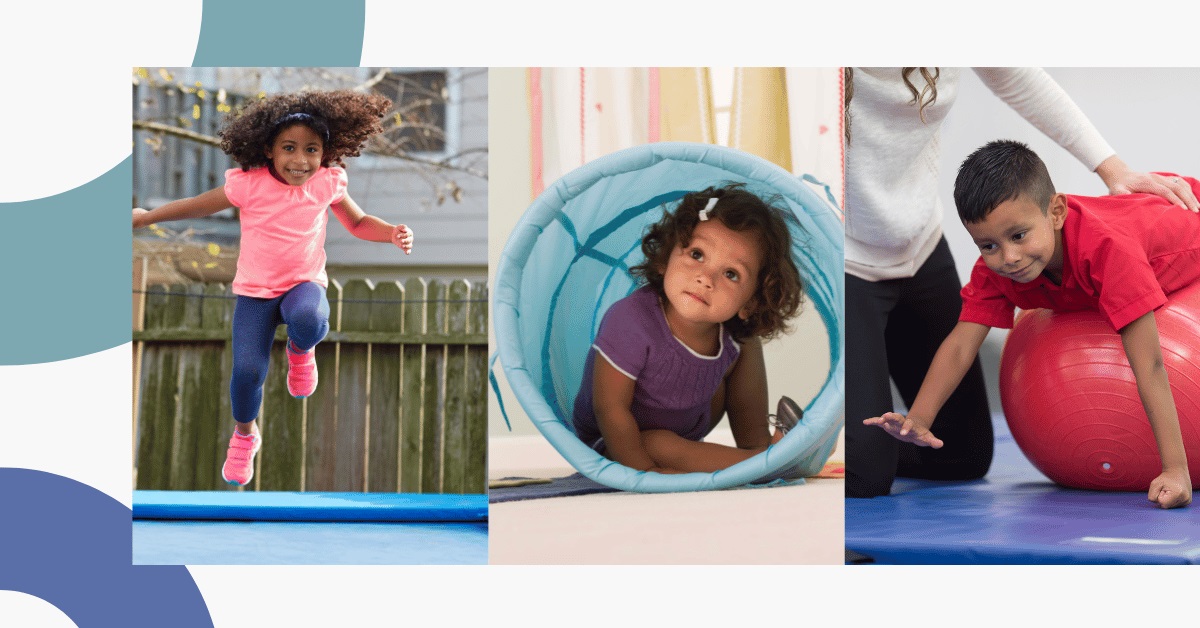
Sensory Processing and Emotional Regulation: How Proprioception Helps
I. Introduction
Sensory processing is how our nervous system transforms sensory input into suitable motor and behavioral reactions. Proprioception, despite its crucial function in our interactions with the world, is often overlooked among the several sensory systems. Proprioception, usually known as the perception of body position and movement, is crucial for maintaining balance, coordination, and emotional equilibrium. This article explores the role of proprioceptive input in sensory processing and emotional regulation.
II. Understanding Sensory Processing
Sensory processing refers to the brain’s ability to interpret and organize sensory information from the environment and the body. This intricate process enables us to function smoothly in everyday life, affecting everything from movement to emotional regulation. Sensory processing involves several sensory systems, each contributing uniquely to our perception and interaction with the world around us:
Visual System
The visual system processes information received through the eyes. It allows us to interpret light, color, shape, and movement, enabling us to navigate our environment, recognizes faces, and read.
Auditory System
The auditory system interprets sounds and helps us understand our environment. This system processes everything from the pitch and volume of a sound to its direction and distance.
Tactile System
The tactile system relates to touch and how we perceive different textures, temperatures, and pressures. It provides critical information about the physical characteristics of objects and surfaces.
Olfactory System
The olfactory system concerns our sense of smell. It plays a significant role in detecting odors and so with influencing taste.
Gustatory System
The gustatory system deals with taste. It lets us perceive different flavors: sweet, salty, sour, bitter, and umami.
Vestibular System
The vestibular system helps with balance and spatial orientation. Located in the inner ear, it detects changes in head position and movement, enabling us to maintain balance and posture.
Proprioceptive System
The proprioceptive system informs muscles, tendons, and joints about body position and movement. It allows us to move smoothly and accurately without constantly watching our limbs.
When sensory processing works well, the various sensory systems collaborate seamlessly, allowing us to respond appropriately to sensory stimuli. This integrated processing enables us to navigate and interact with our environment efficiently, maintain balance and coordination, communicate effectively, perform daily activities easily, and regulate our emotions and behaviors. The harmonious functioning of these sensory systems is essential for overall well-being, helping us engage with the world in a balanced and effective manner.
However, disruptions in sensory processing can lead to sensory processing disorders (SPD). Individuals with SPD may experience hypersensitivity or hyposensitivity to sensory inputs, affecting their ability to function and interact with the world. For instance, hypersensitivity can cause individuals to overreact to sensory stimuli, such as being bothered by loud noises, bright lights, or certain textures. This can lead to avoidance behaviors, anxiety, and difficulties in focusing. On the other hand, hyposensitivity can cause individuals to underreact to sensory stimuli, requiring more intense input to register sensations. This can result in sensory-seeking behaviors, such as craving deep pressure, spinning, or making loud noises.
III. The Role of Proprioception in Sensory Processing
Proprioception plays a pivotal role in sensory processing by providing the brain with essential information about body position, movement, and muscle force. Often referred to as the “sixth sense,” proprioception is crucial for coordinated movement and body awareness. Here’s how it functions:
Feedback Mechanism
Proprioceptive receptors in muscles, tendons, and joints send continuous feedback to the brain regarding body position and movement. This constant flow of information allows the brain to monitor and adjust our physical actions, ensuring that we maintain proper posture and execute movements accurately.
Motor Planning
The feedback provided by proprioceptive receptors is essential for motor planning. It helps the brain plan and execute precise movements, which are necessary for performing everyday tasks. Whether walking, writing, or picking up an object, proprioceptive input ensures that our movements are smooth, coordinated, and efficient.
Balance and Coordination
Proprioceptive input is integral to maintaining balance and coordinating movements. By constantly updating the brain on the body’s position in space, proprioception helps us stay upright and stable, whether we’re standing still or moving. It enables us to engage in physical activities requiring complex coordination, such as dancing, playing sports, or simply navigating a crowded space.
For individuals with Sensory Processing Disorder (SPD), the proprioceptive system may not function optimally, leading to significant challenges. These individuals might experience motor skills, coordination, and emotional regulation difficulties. For instance, some may seek out more proprioceptive input through activities like jumping, squeezing, or pushing heavy objects—a behavior known as sensory seeking. These actions provide the intense sensory feedback their bodies crave. Conversely, others may avoid proprioceptive input due to hypersensitivity, leading to sensory avoidance behaviors. This can manifest as discomfort or distress during activities that involve physical contact or pressure, resulting in withdrawal from such experiences.
IV. Proprioception and Emotional Regulation
Emotional regulation refers to managing and responding to emotional experiences appropriately. This crucial skill enables individuals to navigate their emotions effectively, leading to better mental health and well-being. Proprioceptive input can significantly impact emotional regulation through several mechanisms, playing a vital role in helping individuals, especially those with sensory processing challenges, maintain emotional balance.
Calming Effect
One of the most profound effects of proprioceptive input is its ability to calm the nervous system. Activities that provide deep pressure, such as using weighted blankets or body socks, have a soothing effect that can help reduce anxiety and stress. The gentle, consistent pressure from these tools stimulates the release of neurotransmitters like serotonin and dopamine, which promote feelings of relaxation and contentment. This calming effect is particularly beneficial for individuals who experience heightened levels of stress or anxiety, as it helps them feel more secure and at ease.
Self-Regulation
Proprioceptive activities are crucial in helping individuals maintain a balanced state of arousal, which is essential for effective self-regulation. Regular engagement in proprioceptive activities helps prevent sensory overload, a condition where the brain becomes overwhelmed by too much sensory information. By providing consistent proprioceptive input, individuals can achieve a more stable arousal level, making managing their reactions to sensory stimuli easier. This improved self-regulation allows them to respond more appropriately to their environment, leading to better emotional control and resilience.
Stress Reduction
Engaging in proprioceptive activities has been shown to reduce cortisol levels, the hormone associated with stress. High cortisol levels can negatively impact mood, cognitive function, and overall health. Proprioceptive input helps lower cortisol levels, promoting a sense of calm and well-being. Activities like yoga, resistance exercises, and deep-pressure massages are effective ways to incorporate proprioceptive input into daily routines, helping individuals manage stress more effectively and maintain a positive emotional state.
For children with autism or ADHD, who often struggle with sensory processing and emotional regulation, proprioceptive activities can provide the necessary input to help them feel more grounded and in control of their emotions. These children may experience frequent sensory overload or have difficulty managing their responses to sensory stimuli, leading to emotional outbursts or withdrawal. Incorporating proprioceptive activities into their daily routines can help mitigate these challenges.
For example, children with autism or ADHD might benefit from tools like therapy balls, sensory swings, or weighted vests. These tools provide consistent proprioceptive input, helping them stay calm and focused. Structured play activities that involve pushing, pulling, or lifting heavy objects can also be beneficial, as they engage the proprioceptive system and promote better body awareness and coordination.
In addition to these tools and activities, incorporating proprioceptive input into therapy sessions can enhance their effectiveness. Occupational therapists often use proprioceptive activities as part of sensory integration therapy, helping children develop better sensory processing and emotional regulation skills. By tailoring these activities to each child’s needs, therapists can provide targeted support that addresses specific sensory challenges and promotes overall well-being.
Overall, the role of proprioception in emotional regulation is profound and multifaceted. By leveraging proprioceptive input, individuals can achieve better self-regulation, reduce stress, and enhance their ability to manage emotions effectively. For those with sensory processing challenges, incorporating proprioceptive activities into their daily routines can significantly impact their ability to navigate the world with confidence and emotional stability.
Sensory processing and emotional regulation are intricately linked processes that profoundly impact our daily lives. Sensory processing involves various sensory systems working together seamlessly to interpret and respond to stimuli from our environment and bodies. Among these systems, proprioception is crucial, providing essential feedback about body position, movement, and muscle exertion.
Proprioceptive input plays a vital role in physical coordination, motor skills, and emotional regulation. Individuals can experience various benefits that contribute to their overall well-being by engaging in proprioceptive activities. These activities provide deep pressure and sensory feedback that promote relaxation, reduce anxiety, and enhance self-regulation.
For individuals with sensory processing disorders (SPD), proprioceptive activities can be particularly transformative. They offer avenues for managing sensory sensitivities and improving emotional resilience. By incorporating proprioceptive input into daily routines and therapeutic interventions, individuals can develop better coping mechanisms and achieve greater independence in navigating their sensory experiences.
Understanding the profound impact of proprioception on emotional regulation underscores the importance of integrating sensory strategies into educational, therapeutic, and home environments. By fostering environments that support sensory needs and promote proprioceptive engagement, we can empower individuals to thrive and lead fulfilling lives.
What is proprioception?
Proprioception is the body’s ability to sense its position, movement, and the force exerted by muscles, which is crucial for coordination and balance. This sensory feedback allows us to navigate our environment, perform precise movements, and maintain stability without consciously monitoring every action.
How does proprioception affect emotional regulation?
Proprioception plays a significant role in emotional regulation by providing calming and organizing input to the nervous system. Activities that involve proprioceptive stimulation, such as using weighted blankets or engaging in therapeutic exercises with resistance bands, can reduce stress and anxiety levels. This sensory input helps individuals achieve a more balanced emotional state, enhancing their ability to effectively manage and respond to emotions.
What are some common proprioceptive activities?
Common proprioceptive activities include using weighted blankets for deep pressure stimulation, wearing body socks to enhance body awareness, sitting or bouncing on therapy balls to engage core muscles, swinging on sensory swings to stimulate the vestibular system, and performing exercises with resistance bands to improve muscle strength and proprioception.
Who can benefit from proprioceptive activities?
Proprioceptive activities are beneficial for individuals with sensory processing disorders (SPD), autism spectrum disorder (ASD), attention-deficit/hyperactivity disorder (ADHD), and anyone seeking to improve emotional regulation and physical coordination. These activities can provide essential sensory input that su pports better self-regulation and overall well-being.
How often should proprioceptive activities be performed?
The frequency of proprioceptive activities can vary based on individual needs and preferences. However, incorporating these activities into daily routines can provide consistent sensory processing and emotional regulation benefits. Regular engagement in proprioceptive activities helps maintain optimal sensory integration and supports improvements in ongoing motor skills and emotional resilience.
Are there any risks associated with proprioceptive activities?
When conducted appropriately and under supervision or guidance from qualified professionals, proprioceptive activities are generally safe. Choosing activities and tools suitable for the individual’s age, abilities, and sensory preferences is essential. Practicing proper techniques and ensuring adequate supervision can minimize any potential risks associated with these activities.

